Ford F-Series
 |
|
| Manufacturer | Ford Motor Company |
|---|---|
| Production | 1948–present |
| Successor | Ford Super Duty (F-250 & F-350) |
| Class | Full-size pickup truck |
| Layout | Front engine, rear-wheel drive / four-wheel drive |
The F-Series is a series of full-size pickup trucks from Ford Motor Company sold for over six decades. The most popular variant of the F-Series is the F-150. It was the best-selling vehicle in the United States for 24 years and has been the best-selling truck for 34 years,[1] though this does not include combined sales of GM pickup trucks.[2] Analysts estimate that the F-Series alone makes up half of the Ford Motor Company's profits in recent years. In the tenth generation of the F-series, the F-250HD and F-350 which were changed to diesel fuel changed body style in 1998 and joined the Super Duty series.
First generation (1948–1952)
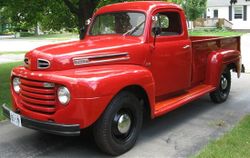 |
|
| Production | 1948–1952 |
|---|---|
| Assembly | Dearborn, Michigan, USA Edison, New Jersey, USA Long Beach, California, USA Norfolk, Virginia, USA St. Paul, Minnesota, USA St. Louis, Missouri, USA Hapeville, Georgia, USA Highland Park, Michigan, USA |
| Body style(s) | 2-door pickup 4-door panel truck |
| Engine(s) | 226 cu in (3.7 L) Straight-6 239 cu in (3.9 L) Flathead V8 254 cu in (4.2 L) Straight-6 337 cu in (5.5 L) Flathead V8 215 cu in (3.5 L) Straight-6 279 cu in (4.6 L) Y-block V8 317 cu in (5.2 L) Y-block V8 |
| Transmission(s) | 3-speed manual 4-speed manual 5-speed manual |
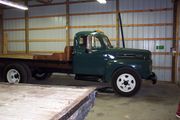
The first F-Series truck (known as the Ford Bonus-Built) was introduced in 1948, replacing the company's previous car-based pickup line. It was a modern-looking truck with a flat, one-piece windshield and integrated headlights. Options were the "See-Clear" windshield washer (operated by foot plunger), passenger side windshield wiper & sun visor, and passenger side taillight. The F-1 truck was also available with additional chrome and two horns as an option. All F-series were available in "Marmon-Herrington All Wheel Drive" until 1959. A Mercury-badged version of this F-Series was sold only in Canada.
Design of the F-Series truck changed little from 1948 to 1952. From 1948–1950, the grill was a series of horizontal bars and the headlights were set into the fenders. For 1951 and 1952, the headlights were connected by a wide aerodynamic cross piece with three similarly aerodynamic supports. The rear window was wider in the later trucks and the dashboard was redesigned.
F-series trucks were built at sixteen different Ford plants. Serial numbers indicate the truck model, engine, year, assembly plant, and unit number. The most common model was the F-1 with a 6 ½-foot bed followed by the F-2 and F-3 Express models with an 8-foot (2.4 m) bed.
The models are:
- F-1: 1/2 ton (4,700 GVWR max)
- F-2: 3/4 ton (5,700 GVWR max)
- F-3: Heavy Duty 3/4 ton (6,800 GVWR max)
- F-3: Parcel Delivery (7,000 GVWR max) & optional rear spring pkg (7,800 GVWR max)
- F-4: 1 ton (7,500 GVWR max) & optional 1¼ ton pkg (10,000 GVWR max)
- F-5: 1½ ton: Conventional, school bus, and cab over engine (C.O.E.) (10,000–14,500 GVWR)
- F-6: 2 ton: Conventional, school bus, and C.O.E. (14,000–16,000 GVWR)
- F-7: Conventional (17,000–19,000 GVWR)
- F-8: Conventional (20,000–22,000 GVWR)
Engines:
| Engine | Years | Power | Usage |
|---|---|---|---|
| 226 CID Flathead 6 | 1948–51 | 95 hp (71 kW) at 3,300 rpm | F-1 through F-6 |
| 239 CID Flathead V8 | 1948–52 | 100 hp (75 kW) at 3,800 rpm | F-1 through F-6 |
| 254 CID Flathead 6 | 1948–51 | 110 hp (82 kW) at 3,400 rpm | F-6 only |
| 337 CID Flathead V-8 | 1948–51 | 145 hp (108 kW) at 3,600 rpm | F-7 and F-8 |
| 215 CID OHV Straight-6 | 1952–53 | 101 hp (75 kW) | |
| 279 Y-block (EAL) | 1952–55 | 145 hp (108 kW) at 3,800 rpm | F-7 only |
| 317 Y-block (EAM) | 1952–55 | 155 hp (116 kW) at 3,900 rpm | F-8 only |
Transmissions:
- 3-speed light duty, F-1 only
- 3-speed heavy duty, F-1 through F-5
- 4-speed (spur gear), F-1 through F-6
- 4-speed Synchro-Silent, F-4 through F-6
- 5-speed overdrive, F-7 and F-8
- 5-speed direct drive, F-7 and F-8
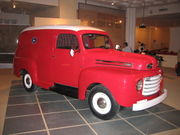
Second generation (1953–1956)
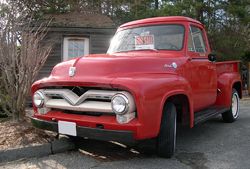 |
|
| Production | 1953–1956 |
|---|---|
| Assembly | Dearborn, Michigan, USA Edison, New Jersey, USA Long Beach, California, USA Norfolk, Virginia, USA St. Paul, Minnesota, USA St. Louis, Missouri, USA São Paulo, Brazil Hapeville, Georgia, USA Louisville, Kentucky, USA San Jose, California, USA Highland Park, Michigan, USA |
| Body style(s) | 2-door pickup 4-door panel truck |
| Engine(s) | 215 CID (3.5 L) I6 223 CID (3.7 L) Mileage Maker I6 239 CID (3.9 L) Flathead V8 239 CID (3.9 L) Y-block V8 272 CID (4.5 L) Y-block V8 |
The F-Series was redesigned for 1953 with a more integrated look. The pickups also acquired their now familiar names: The F-1 now became the F-100, the F-2 now became the F-250, and the F-3 now became the 1 ton F-350. Starting on the 1956 models, Ford offers the very rare "Low GVWR" versions of each model. Optional interior amenities were new, including a dome light, lighter, arm rests, sun visors and a radio. On March 13, 1953, "Ford-O-Matic" automatic transmissions became an option.
The 1953 F-100 was the last year for the flathead in the US. Canadian models, however, (Mercury M-Series), retained the flathead. 1954 saw the introduction of the new 239 CID overhead valve Y-block 8 cylinder, dubbed "Power King." The six cylinder engine's displacement was also increased from 215 to 223 CID and power steering was introduced as an option.. In 1955 the 239 Y-block was replaced with the 272 and 292. The 1956 F-100 is easily identified as it has vertical windshield pillars as opposed to the sloped pillars of the 1953-55. The 1956 model also offered a larger wrap-around back window as an option.
Second generation trucks were built in Brazil from 1957 to 1962 as the F-100, F-350 and F-600.
Models:
- F-100: 1/2 ton (5,000 GVWR max)
- F-110: 1/2 ton (4,000 GVWR max)
- F-250: 3/4 ton (7,400 GVWR max)
- F-260: 3/4 ton (4,900 GVWR max)
- F-350: 1 ton (9,800 GVWR max)
- F-360: 1 ton (7,700 GVWR max)
Engines:
| Engine | Years | Power |
|---|---|---|
| 215 CID Straight-6 | 1953 | 101 hp (75 kW) |
| 239 CID Flathead V8 | 1953 | 100 hp (75 kW) |
| 223 CID Mileage Maker I6 | 1954–55 | 115 hp (86 kW) |
| 239 CID Y-block V8 | 1954–55 | 130 hp (97 kW) |
| 223 CID Mileage Maker I6 | 1956 | 137 hp (102 kW) |
| 272 CID Y-block V8 | 1956 | 173 hp (129 kW) |
 1953 Mercury M-100, a Canada only rebadged F-100 |
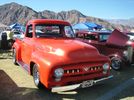 1953 Ford F-100 |
 1955 Ford F-100 (rear) |
.jpg) 1956 Mercury M-100 pickup |
Third generation (1957–1960)
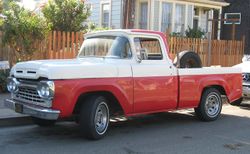 |
|
| Production | 1957–1960 |
|---|---|
| Assembly | Dearborn, Michigan, USA Edison, New Jersey, USA Kansas City, Missouri, USA Long Beach, California, USA Norfolk, Virginia, USA St. Paul, Minnesota, USA St. Louis, Missouri, USA La Boca, Argentina São Paulo, Brazil Hapeville, Georgia, USA Louisville, Kentucky, USA San Jose, California, USA Wayne, Michigan, USA Lorain, Ohio, USA |
| Body style(s) | 2-door pickup |
| Engine(s) | 223 CID (3.7 L) Mileage Maker I6 272 CID (4.5 L) Y-block V8 292 CID (4.8 L) Y-block V8 |
The truck was restyled again in 1957 with a hood that now sat flush with the fenders and a new chrome grille. In the back, the traditional separate-fender body was now called flareside, while a new smooth-sided look was known as styleside. Four wheel drive drive-train, which was previously outsourced to Marmon-Herrington, was produced in-house by Ford Motor Company beginning in 1959. Ford still offers a "Low GVWR" version of each model. In May 1957 Ford discontinued building trucks at the Highland Park Ford Plant in Highland Park, Michigan. All heavy trucks were transferred to Kentucky Truck Assembly in Louisville, Kentucky. All light and medium trucks were transferred to 10 other plants in the USA.
Third generation trucks were built in Brazil as the F-100, F-350 & F-600 from 1962 to 1971.
Models:
- F-100 (F10, F11, F14): 1/2 ton (4,000–5,000 GVWR max)
- F-100 (F18, F19)(4X4): 1/2 ton (4,000–5,600 GVWR max)
- F-250 (F25, F26): 3/4 ton (4,900–7,400 GVWR max)
- F-250 (F28, F29)(4X4): 3/4 ton (4,900–7,400 GVWR max)
- F-350 (F35, F36): 1 ton (7,700–9,800 GVWR max)
Engines:
| Engine | Years | Power |
|---|---|---|
| 223 CID Mileage Maker I6 | 1958–60 | 137 hp (102 kW) |
| 272 CID Y-block V8 | 1958 | 173 hp (129 kW) |
| 292 CID Y-block V8 | 1959–60 | 186 hp (139 kW) |
 1957 Ford F-100 Panel Van |
 Ford F-600 Fire Truck |
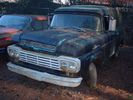 1959 Ford F-100 Panel Van |
1960 Ford F-Series pickup in Frankfurt, Germany |
Fourth generation (1961–1966)
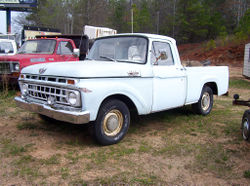 |
|
| Production | 1961–1966 |
|---|---|
| Assembly | Cuautitlan, Mexico Dearborn, Michigan, USA Edison, New Jersey, USA Kansas City, Missouri, USA Long Beach, California, USA Norfolk, Virginia, USA St. Paul, Minnesota, USA St. Louis, Missouri, USA General Pacheco, Argentina Hapeville, Georgia, USA Louisville, Kentucky, USA San Jose, California, USA Wayne, Michigan, USA Lorain, Ohio, USA Oakville, Ontario, Canada |
| Body style(s) | 2-door pickup 4-door pickup |
| Engine(s) | 223 CID (3.7 L) I6 292 CID (4.8 L) Y-block V8 240 CID (3.9 L) I6 300 CID (4.9 L) I6 352 CID (5.8 L) FE V8 |
The truck was completely redesigned for 1961 with a wider look, and unibody trucks were available, built with an integrated cab and box, from 1961–63. From 1964 on, only the traditional separate cab and bed arrangement were available. Power was over 200 hp (150 kW) with the 1965 update of the powertrain. In 1965, the Twin I-Beam front suspension was introduced with coil springs and the 300 replaced the 223. 1965 also marked the beginning of a completely different chassis and many parts from 65-79 interchange such as brakes and motor mounts. The 1965 and 1966 trucks have a "TWIN I-BEAM" emblem on the front fender. A 4-door crew cab version was also introduced in 1965, still a popular option.
Ford still offered a "Low GVWR" version of each model.
The Camper Special was built heavier for the slide in campers that were becoming increasingly popular during this time.
In 1965, the name "Ranger" is first introduced as a styling package for the F-Series pickup trucks using mustang bucket seats and a curtain over the gas tank. Then later (1982) the name Ranger is used for Ford's compact series trucks; an entry in the mini-pickup segment. It went on to become the top-selling compact pickup in the American market.
In 1965, the 300-cubic inch (4.9 L) straight six was introduced (a larger version of the 240-cubic inch Six). It had 7 main bearings and timing gears (no chain or belt).
Models:'
- F-100 (F10, F11, F14): 1/2 ton (4,000–5,000 GVWR max)
- F-100 (F18, F19)(4X4): 1/2 ton (4,000–5,600 GVWR max)
- F-250 (F25): 3/4 ton (7,400 GVWR max)
- F-250 (F26)(4X4): 3/4 ton (4,900 GVWR max)
- F-350 (F35): 1 ton (9,800 GVWR max)
Engines: Note: HP in Net HP
| Engine | Years | Power |
|---|---|---|
| 223 CID Mileage Maker I6 | 1961–64 | 114 hp (85 kW) |
| 262 CID Mileage Maker I6 | 1961–64 | 132 hp (98 kW) |
| 292 CID Y-block V8 | 1961–64 | 135 hp (101 kW) |
| 240 CID Straight-6 | 1965–66 | 150 hp (110 kW) |
| 300 CID Straight-6 | 1965–66 | 170 hp (130 kW) |
| 352 CID FE V8 | 1965–66 | 172 hp (128 kW) |
 1961 Ford F-100 Pickup |
 1966 Mercury M-100 |
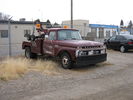 1966 Mercury M-350 Tow Truck |
 1966 Ford F-100 with optional toolbox in side of bed |
Fifth generation (1967–1972)
 |
|
| Production | 1967–1972 |
|---|---|
| Assembly | Cuautitlan, Mexico Dearborn, Michigan, USA Edison, New Jersey, USA Kansas City, Missouri, USA Long Beach, California, USA Norfolk, Virginia, USA St. Paul, Minnesota, USA St. Louis, Missouri, USA General Pacheco, Argentina São Paulo, Brazil Hapeville, Georgia, USA Louisville, Kentucky, USA San Jose, California, USA Wayne, Michigan, USA Oakville, Ontario, Canada |
| Body style(s) | 2-door pickup 4-door pickup |
| Engine(s) | 240 CID (3.9 L) I6 300 CID (4.9 L) I6 352 CID (5.8 L) FE V8 360 CID (5.9 L) FE V8 390 CID (6.4 L) FE V8 302 CID (4.9 L) Windsor V8 |
Another refresh came in 1967 along with a familiar name: the upscale Ranger trim line in addition to the base and Custom Cab trim levels. In 1968, federal regulations required all automotive manufacturers to add side marker reflectors or lights, so Ford redesigned the hood emblems to incorporate reflectors.[3][4] The same year the trucks received larger versions of Ford's FE engine family with the introduction of the 360 and 390 cubic inch engines. Also changed for 1968 were the heater controls, arm rests, interior door handles and window cranks, and the upper trim moulding on models so equipped. Rear side marker reflectors were also added to the lower bed side panels in 1968, per government regulations. The 302 V8 became an option in late '69. The top trim for 1970 was now named Ranger XLT with Ranger, Sport Custom and Custom rounding off the rest of the line. The fifth generation bodies were noted for durability and simplicity of design making them a favorite for restoration.
Some trucks came with an outer flush mounted bed side compartment/tool box on the passenger side only. Trucks from the Fifth Generation can be identified as to year model by their year specific grille arrangements.
After the 1968 models, Ford discontinued the "Low GVWR" versions. Still available was the Camper Special option, along with the new Explorer Special (a trim package), Contractor's Special(including a behind the seat toolbox and 3/4 ton (F-250) suspension), Farm and Ranch Special, and Heavy-Duty Special. Most of these "specials" from 1967–72 were made in relatively low numbers and are now becoming increasingly difficult to locate.
The fifth-generation F-series was introduced in Brazil in 1971, which remained in production until circa 1992[5] with a slight redesign and changes in its motorizations. It was the last Ford truck manufactured in the Ipiranga plant, that was soon closed.
Models:
- F-100: 1/2 ton (5,600 GVWR max)
- F-110: 1/2 ton (4X4)(4,200 GVWR max)
- F-250: 3/4 ton (7,500 GVWR max)
- F-260: 3/4 ton (4X4)(4,800 GVWR max)
- F-350: 1 ton (10,000 GVWR max)
- F-360: 1 ton (4X4)(6,000 GVWR max)
Engines:
| Engine | Years | Power |
|---|---|---|
| 240 CID Straight-6 | 1967–72 | 150 hp (110 kW) |
| 300 CID Straight-6 | 1967–72 | 170 hp (130 kW) |
| 352 CID FE V8 | 1967 | 208 hp (155 kW) |
| 360 CID FE V8 | 1968–72 | 215 hp (160 kW) |
| 390 CID FE V8 | 1968–72 | 255 hp (190 kW) |
| 302 CID Windsor V8 | 1969–72 | 205 hp (153 kW) |
Sixth generation (1973–1979)
 |
|
| Production | 1973–1979 |
|---|---|
| Assembly | Dearborn, Michigan, USA Edison, New Jersey, USA Kansas City, Missouri, USA Louisville, Kentucky, USA Norfolk, Virginia, USA San Jose, California, USA St. Paul, Minnesota, USA Wayne, Michigan, USA Cuautitlan, Mexico General Pacheco, Argentina Oakville, Ontario, Canada |
| Body style(s) | 2-door pickup 4-door pickup |
| Engine(s) | 240 CID (3.9 L) I6 300 CID (4.9 L) I6 352 CID (5.8 L) FE V8 360 CID (5.9 L) FE V8 390 CID (6.4 L) FE 302 CID (5.0 L) Windsor V8 460 CID (7.5 L) 385 V8 351 CID (5.8 L) 335 V8 400 CID (6.6 L) 335 V8 |
The truck was redesigned in 1973; the grille for the 1973 model year featured two silver-metallic plastic inserts divided by an aluminum bar that was part of the main grille frame, with the letters "F O R D" spaced out in a thin rail in the upper part of the grille. Large round headlights were on either side of the grille with the park/turn signal lamps placed above in the same rail where the "FORD" lettering was. Medium-duty models, however, weren't redesigned as drastically as the light-duty trucks. In fact they were incredibly similar to the fifth-generation medium-duty F-Series trucks. In 1976, this familiar "split-grille" design was facelifted slightly to feature black accents around the headlights and a refined appearance overall. In 1978, the round headlight design was retained for the regular Ranger and Custom trim levels. The XLT and "Lariat" trim level incorporated rectangular headlights with optional chrome headlight doors and chrome grille insert. The split grille design was overhauled in favor of a single-piece grille insert design. The headlights were also placed in a more stylized "insert" themselves, and the park/turn signal lamps were now placed below the headlights. Additionally, a new chrome-plated "F O R D" letter set could now be seen on the hood immediately above the grille. A luxury Lariat trim was also introduced for 1978. In 1979, the round headlights were replaced by rectangular headlamps across all the trim levels and the surrounding grille insert that framed the headlamps was now available in either black, or chrome to match that of the aluminum grille frame.

In 1973, a new model was offered, the F350 SRW (single rear wheel) pickup. These were a new heavy duty pickup with contractors and camping enthusiasts in mind. The trucks rode on a longer wheel base chassis but were the same overall length as an F250 pickup. If you ordered the Camper Special package on an F350 SRW it became a Super Camper Special which was designed for the much heavier slide-in campers coming on the market at that time. Other changes included the 1974 introduction of the extended super cab version. The F-150 was introduced in 1975 to help circumvent coming emissions requirements. These came with a maximum payload of 2,275 lb (1,032 kg) when properly equipped. With the 1/2 ton F-100 still in production, the new F-150 was referred to as the "heavy half" ton by some people.
In 1976, the F-series became the best-selling truck in America, a position it has continued to hold since. This generation is noted for the durability of the body panels as Ford used extensive amounts of galvanized sheet metal to fight corrosion. 1977 was the first year for smaller cowl insignias moved near the windshield and the last year for the medium-duty F-500.
The GVWR ratings for these trucks was tied to a combination of wheel, spring, axle and brake combinations. The series code on the ID tag denotes which model and from that it can be determined what weight rating each vehicle has. 4X4 trucks can also be identified by the VIN number and on the ID plate as a serial number. For example, F10 is an F-100 2 wheel drive but F11 is an F-100 4X4, and so on. Serial numbers beginning with an X are SuperCab models.
Starting in 1978, Ford redesigned their Ford Bronco and based it upon the F-150. The Bronco was now virtually identical to the F-150, except for the unibody design structure. The new Bronco incorporated design characteristics which eliminated leaky roofs and body flex associated with other full size removable top utility vehicles of the era. This allowed Ford to compete better with the Chevrolet Blazer by offering a larger and more luxurious SUV while minimalizing production costs since many (especially the most complex and expensive) parts were shared with the F-series trucks. The Bronco was only offered with the 351M and 400 V8 engines
Models:
- F100 F101 F102 F103 F104 F105 F106 F107 F108 F109 F10N: 1/2 ton (4,550–5,700 GVWR max)
- F110 F111 F112 F113 : 1/2 ton (4X4)(5,250–6,500 GVWR max)
- F150 F151 : "heavy" 1/2 ton (6,050–6,200 GVWR max)
- F140 F141 F142 F143: "heavy" 1/2 ton (6,050–6,500 GVWR max)
- F250 F251 F252 F253 F254 F255 F256 F257 F258 F259: 3/4 ton (6,200–8,100 GVWR max)
- F260 F261 F262 F263 F264 F265 F266: 3/4 ton (4X4) (6,500–8,400 GVWR max)
- F350 F350 F351 F352 F353 F354 F355 F356 F357 F358 F359 F35P: 1 ton (6,000–10,000 GVWR max)
- F-360: 1 ton (4X4) (8,550 GVWR max)
Engines:
| Engine | Years | Power (SAE net) |
|---|---|---|
| 240 CID Straight-6 | 1973–77 | |
| 300 CID I6 | 1973–79 | |
| 302 CID Windsor V8 | 1969–72 | 130 hp (97 kW) |
| 352 CID FE V8 | 1973–77 | |
| 360 CID FE V8 | 1973–76 | 145 hp (108 kW) |
| 390 CID FE V8 | 1973–77 | 195 hp (145 kW) |
| 460 CID 385 V8 | 1973–79 | 200–220 hp (150–162 kW) |
| 351 CID 351M V8 | 1977–79 | 163 hp (122 kW) |
| 400 CID 400M V8 | 1977–79 | 169 hp (126 kW) |
 1973–1975 Ford F-100 XLT |
 1977 Ford F-150 Explorer |
 1978 – 79 Ford F100 Custom XLT, with right-hand drive in Australia |
 1978 Ford F-250 |
Seventh generation (1980–1986)
| Production | 1980–1986 |
|---|---|
| Assembly | Cuautitlan, Mexico Dearborn, Michigan, USA Kansas City, Missouri, USA Norfolk, Virginia, USA St. Paul, Minnesota, USA General Pacheco, Argentina Louisville, Kentucky, USA Wayne, Michigan, USA Oakville, Ontario, Canada, San Jose, California,USA |
| Body style(s) | 2-door pickup 4-door pickup |
| Engine(s) | 300 CID (4.9 L) I6 255 CID (4.2 L) Windsor V8} 302 CID (5.0 L) Windsor V8} 351 CID (5.8 L) Windsor V8 400 CID (6.6 L) 335 V8 460 CID (7.5 L) 385 V8 6.9 L (420 CID) Diesel V8 |

The next major redesign came in 1980. The new truck had a squarer look, with sharp lines and flat panels; the trucks were designed with improved fuel efficiency in mind, and to this end, Ford added its new AOD automatic overdrive (four-speed) transmission as an option on light-duty models. Also new was Ford's first use of an independent front suspension on 4X4 models. The Ranger trim line was dropped from the F-Series in 1982, since that name was to be applied to the new Ford Ranger compact pickup, which replaced the Ford Courier mini-pickup line. Trim options became XL, XLS, XLT, and XLT Lariat. In 1982 the "F-O-R-D" letters were removed from the hood and a blue oval logo appeared on a slightly re-designed grille that featured fewer vertical bars than the previous 1980–1981 grille.
The big-block 460 CID V8 was dropped for 1980, but returned in 1983 along with the 6.9 L V8 International Harvester IDI option. In 1982, the 335-series "Cleveland" V8s were discontinued. The 351M was replaced by the 351 Windsor (an older design that now made its debut in light trucks), while the 400 vanished altogether (Ford's competitors had ceased selling engines in that size range a few years before). The 5.0 L V8 switched over to fuel injection, first as an option in 1985 and then as standard in 1986.
The new Essex V6 was added in 1982, but didn't sell particularly well. It was dropped after 1983, and the long-lived 300 inline six continued as the standard engine through the series. Trucks equipped with the 3-speed manual transmission were the last American vehicles to have a column-shifted manual transmission.
The F-100 was dropped as the base model at the end of 1983 and the now-familiar F-150 took its place as the base model F-Series truck for 1984. This generation also saw extensive use of galvanized body panels to fight corrosion which is now gaining them popularity among restorers.
The various changes that occurred between the 1981 and 1982 model years were accompanied by a slight cosmetic change- 1980–81 trucks have a plain grille with "FORD" spelled across the front of the hood in chrome letters, similar to the previous generation. 1982–86 models had the letters removed, and a Ford oval placed in the center of the grille. This made the 1982 the first model year to feature a blue oval on the front, something that has been on every model that followed it, with the exception of the 2010 F-150 SVT Raptor.[6]
This generation saw two different sets of trim levels:
In 1980 and 1981, there was:
- Custom- Mainly Base model with manual locks/windows, vinyl seat, and black rubber floor mat,but could be had with other options.
- Ranger- Intermediate trim that added a color-keyed floor mat, chrome trim on the door panels,and woodtone dash trim.
- Ranger XLT- A step up from the Ranger that added better seat trim, a color-keyed headliner, color-keyed carpeting, aluminum tailgate trim and optional power windows/locks.
- Ranger Lariat- a step above the XLT that added a plusher interior,and Woodgrain Trim on the door panels.It also featured special "Lariat" emblems on the cab,as well as Ranger Lariat script above the radio.
For 1982–1986:
- Base – basically the same as the Custom of the previous years.
- XL – replaced the intermediate Ranger trim for 1982 as the Ranger name would be used for Ford's new compact truck.
- XLS- a new trim level that featured a blacked-out grille, bumpers, headlight bezels, and windshield trim. It also featured a stripe graphics package and black and silver dash trim. Available exterior colors were red, silver, and black.
- XLT Lariat- featured floor carpeting, color-keyed headliner, a standard chrome grille, and optional power windows/door locks.1984 saw the last year for woodgrain trim on the door panels as 1985–1986 models had a carpeted section applied to the door panels.In 1985 the tailgate trim was changed to a "flat" full width aluminum with a red "reflector" towards the bottom with chrome FORD letters.
- Explorer – Could be had with any interior setup. The "Explorer" trim line received a higher geared rear end, an AM/FM radio, chrome bumpers, chrome fender well trim, and a chrome grill. The Explorer Line would later be dropped to introduce the Ford Explorer SUV in 1991.Explorer packages changed every year,and were only offered for a limited time each model year.
This generation of Ford trucks are the latest to become popular restoration projects as most of these trucks are becoming emissions exempt in most states and now old enough to be registered as classics or antiques.
In Mexico, there is an "F-200" which was introduced in 1976. This variant remained until 1991.
Engines:
| Engine | Years | Power | Torque | Notes | |
|---|---|---|---|---|---|
| 232 CID Essex V6 | 1982–83 | 110 hp (82 kW) | 183 lb·ft (248 N·m) | ||
| 255 CID Windsor V8 | 1980–81 | 115 hp (86 kW) | 206 lb·ft (279 N·m) | 2bbl | |
| 300 CID Straight-6 | 1980 | 117 hp (87 kW) | 227 lb·ft (308 N·m) | 1bbl | |
| 300 CID† Straight-6 | 1980 | 120 hp (89 kW) | 229 lb·ft (310 N·m) | 1bbl | |
| 300 CID Straight-6 | 1981–86 | 122 hp (91 kW) | 255 lb·ft (346 N·m) | 1bbl | |
| 302 CID Windsor V8 | 1980–85 | 133 hp (99 kW) | 233 lb·ft (316 N·m) | 2bbl | |
| 302 CID Windsor V8 | 1985–86 | 185 hp (138 kW) | 270 lb·ft (366 N·m) | EFI | |
| 351 CID 351M V8 | 1980–82 | 136 hp (101 kW) | 262 lb·ft (355 N·m) | 2bbl | |
| 351 CID Windsor V8 | 1980–82 | 136 hp (101 kW) | 262 lb·ft (355 N·m) | 2bbl | |
| 351 CID Windsor V8 | 1983–85 | 150 hp (110 kW) | 280 lb·ft (380 N·m) | 2bbl | |
| 351 CID HO Windsor V8 | 1984–86 | 210 hp (160 kW) | 305 lb·ft (414 N·m) | 4bbl | |
| 400 CID† 400 V8 | 1980–82 | 136 hp (101 kW) | 310 lb·ft (420 N·m) | 2bbl | |
| 420 CID Navistar diesel V8† | 1983–86 | 170 hp (130 kW) | 315 lb·ft (427 N·m) | IDI | |
| 460 CID† 385 V8 | 1983–84 | 225 hp (168 kW) | 380 lb·ft (515 N·m) | 4bbl | |
| 460 CID† 385 V8 | 1985–86 | 245 hp (183 kW) | 385 lb·ft (522 N·m) | 4bbl |
† Only available F-250 HD and F-350
† † 1984–85 only available on HD F-250 and F-350 models, 1986 available all models
Eighth generation (1987–1991)
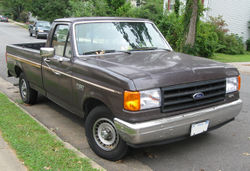 |
|
| Production | 1987–1991 |
|---|---|
| Assembly | Cuautitlan, Mexico Kansas City, Missouri, USA Norfolk, Virginia, USA General Pacheco, Argentina São Bernardo do Campo, Brazil Louisville, Kentucky, USA Wayne, Michigan, USA Oakville, Ontario, Canada |
| Body style(s) | 2-door pickup 4-door pickup |
| Engine(s) | 4.9 L (300 CID) I6 5.0 L (302 CID) V8 5.8 L (351 CID) V8 7.5 L (460 CID) V8 |
| Transmission(s) | C6 3-speed automatic 4-speed automatic 4-speed manual 5-speed manual |
| Wheelbase | 116.8 in (2,967 mm) 133.0 in (3,378 mm) 138.8 in (3,526 mm) 155 in (3,937 mm) 168.4 in (4,277 mm) |
| Length | 194.1 in (4,930 mm) 215.9 in (5,484 mm) 232.2 in (5,898 mm) 210.2 in (5,339 mm) 245.7 in (6,241 mm) |
| Width | 79 in (2,007 mm) |

The 1987 design was more streamlined, and maintenance items were made simpler. Rear antilock brakes were now standard, and the first truck to boast this. The manual transmission was revised with five speeds in 1988, and the flareside box was dropped. For 1987 the 4.9 L (300 CID) had standard fuel injection; for 1988, the 351 CID (5.8 L) and 7.5 L (460 CID) also gained fuel injection, with 1988 being the first year no carbureted engines were offered. 1988 also saw the replacement of the 6.9 L (420 CID) diesel V8 with a 7.3 L (445 CID) International Harvester IDI diesel V8 (now making 180 hp (130 kW). and 365 ft·lbf (495 N·m). of torque).
Four wheel drive improvements included the addition of automatic locking hubs for the F-150 in 1989, and for the rest in 1991. Starting in 1980 (to 1996), Ford offered a four-wheel-drive swing arm independent front suspension called Twin-Traction Beam, or TTB. Based on its I-beam suspension from the mid '60s, Ford mounted a Dana 44 differential in the driver-side (front) axle beam and transmitted torque to the passenger-side wheel with a double U-jointed axleshaft. Radius arms and coil springs were still used on the F-150's, while the four-wheel-drive F-250s and F-350s got leaf springs. The F-250s received TTB Dana 50 axles and the F-350s got a solid axle Dana 60. The 5.0 L (302 CID) truck also had an optional "Touch Drive" electronic transfer case. Custom, XL, XLT, and XLT Lariat were the trim options available. Towards the end of this generation, there was the addition of the behind cab cargo light.
For 1991, a new "Nite" trim package was introduced. It included all blacked-out exterior trim and either a pink or blue/purple stripe and "Nite" decal on the sides of the cargo box. Some sources report that a sport suspension was included, although this is not certain.
The "F-Super Duty" (as the fender emblems stated) models appeared from 1987 to 1997. They were basically F-450s built as an "incomplete vehicle" (chassis cab) due to the fact that there was no bed installed and an aftermarket bed (specific to its future use) was added after the truck's initial build date. It came with dual fuel tanks with a dash-mounted toggle switch to switch between each tank while using only the one fuel gauge. It came with a PTO (Power Take-Off) used to power attachments (like winches or a dump bed) from the transmission. They were rated at about 15,000 lb (6,800 kg) GVWR (Gross Vehicle Weight Rating). They came with either the standard 7.5 L (460 CID) gas V8 or the optional 7.3 L (445 CID) diesel V8. All wheels were 10-lug with DRW (Dual Rear Wheels). This model should not be confused with the "Super Duty" commercial line of trucks starting with the 1999 model year.
The models are:
- F-150: 1/2 ton (6,250 lb GVWR max)
- F-250: 3/4 ton (8,800 lb GVWR max)
- F-350: 1 ton (11,000 lb GVWR max)
- F-Super Duty: 1 ton plus (15,000 lb GVWR max)
Engines:
| Engine | Years | Power | Torque | Notes |
|---|---|---|---|---|
| 4.9 L I6 | 1987–91 | 165 hp (123 kW) | 275 lb·ft (373 N·m) | EFI |
| 5.0 L V8 | 1987–91 | 185 hp (138 kW) | 270 lb·ft (370 N·m) | EFI |
| 5.8 L V8 | 1987 | 210 hp (160 kW) | 305 lb·ft (414 N·m) | 4-bbl. |
| 5.8 L V8 | 1988–91 | 210 hp (160 kW) | 315 lb·ft (427 N·m) | EFI |
| 7.5 L V8 | 1987 | 225 hp (168 kW) | 362 lb·ft (491 N·m) | 4-bbl. |
| 7.5 L V8 | 1988–91 | 230 hp (170 kW) | 390 lb·ft (530 N·m) | EFI |
| 6.9 L Diesel V8 | 1987 | 170 hp (130 kW) | 310 lb·ft (420 N·m) | IDI |
| 7.3 L Diesel V8 | 1988–91 | 180 hp (130 kW) | 345 lb·ft (468 N·m) | IDI |
Ninth generation (1992–1996/1997)
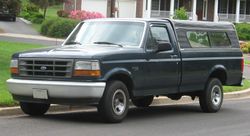 |
|
| Production | 1992–1997 |
|---|---|
| Assembly | Cuautitlan, Mexico Kansas City, Missouri, USA Norfolk, Virginia, USA General Pacheco, Argentina São Bernardo do Campo, Brazil Louisville, Kentucky, USA Wayne, Michigan, USA Oakville, Ontario, Canada |
| Body style(s) |
2-door pickup 4-door pickup |
| Engine(s) | 4.9 L (300 CID) I6 5.0 L (302 CID) V8 5.8 L (351 CID) V8 7.5 L (460 CID) V8 7.3 L (444 CID) diesel V8 (IDI) 7.3 L (444 CID) turbodiesel V8 (IDI Turbo) 7.3 L (444 CID) turbodiesel V8 (DI Turbo, Powerstroke) |
| Transmission(s) | 3-speed C6 automatic 4-speed E4OD automatic 4-speed transmissionFord AOD and AOD-E automatic 4-speed T-18 manual 5-speed M5OD manual 5-speed ZF S5-42 manual 5-speed ZF S5-47 manual |
| Wheelbase | reg. cab longbed: 133 in (3,378 mm) crew cab longbed: 168.4 in (4,277 mm) ext. cab longbed: 155 in (3,937 mm) reg. cab shortbed: 116.8 in (2,967 mm) ext. cab shortbed: 138.8 in (3,526 mm) |
| Length | 197.1 in (5,006 mm) 213.3 in (5,418 mm) 219.1 in (5,565 mm) 235.3 in (5,977 mm) 248.9 in (6,322 mm) |
| Width | 79 in (2,007 mm) |
| Related | Ford Bronco |
The 1992 truck received a new aerodynamic-looking front end, a new dashboard, and the Flareside bed returned. The "Nite" package introduced in 1991 continued, but was dropped at the end of the 1992 model year.
The Lightning Performance Truck appeared as a 1993 model, with more than 20 industry "firsts" or pilot applications, including 17-inch (430 mm) aluminum wheels, gas-charged shocks, and performance handling developed by world-champion driver Jackie Stewart. The Lightning was powered by a special 240 hp (180 kW) version of the 351-cubic-inch (5.8 L) V-8 engine.
The 1994 models brought several changes, including a driver's-side airbag, "CHMSL" third brake light, brake-shift interlock and CFC-free air conditioning. New options in 1994 included remote keyless entry with alarm, a compact disc player fitted into the regular stereo system, and a power driver's seat; an electrochromic inside rear view mirror was also offered in 1994 and 1995 as part of a luxury light package. Following the lead of the Explorer, an Eddie Bauer trim line — featuring plusher trim and increased standard features — was added for 1995.
Ford trailed rival General Motors in combined truck sales for much of the ninth generation, though sales steadily rose each year. 500,000 F-Series trucks were sold in 1992, but this rose to nearly 800,000 by 1996, and the Ford had overtaken the combined Chevrolet and GMC pickup sales for the first time in a decade.
Models:
- F-150: 1/2 ton (6,100 lb GVWR max)
- F-250: 3/4 ton (8,500 lb GVWR max)
- F-250 HD: 1992–1997 Heavy Duty 3/4 ton (9,000 GVWR max)
- F-350: 1 ton (10,000 lb GVWR max)
- F-Super Duty: 1 ton plus (15,000 lb GVWR max)
Engines:
| Engine | Years | Power | Torque | Notes |
|---|---|---|---|---|
| 4.9 L I6 | 1992–93 | 145 hp (108 kW) | 265 lb·ft (359 N·m) | |
| 4.9 L I6 | 1994–96 | 150 hp (110 kW) | 260 lb·ft (350 N·m) | |
| 5.0 L V8 | 1992–93 | 185 hp (138 kW) | 270 lb·ft (370 N·m) | |
| 5.0 L V8 | 1994–96 | 205 hp (153 kW) | 275 lb·ft (373 N·m) | 195 hp (145 kW) for automatic |
| 5.8 L V8 | 1992 | 210 hp (160 kW) | 315 lb·ft (427 N·m) | |
| 5.8 L V8 | 1993 | 200 hp (150 kW) | 310 lb·ft (420 N·m) | |
| 5.8 L V8 | 1993–95 | 240 hp (180 kW)) | 340 ft·lbf (461 N·m) | Lightning Only |
| 5.8 L V8 | 1994–96 | 210 hp (160 kW) | 325 lb·ft (441 N·m) | |
| 7.5 L V8 | 1992–93 | 230 hp (170 kW) | 390 lb·ft (530 N·m) | |
| 7.5 L V8 | 1994–97 | 245 hp (183 kW) | 395 lb·ft (536 N·m) | |
| 7.3 L Diesel V8 | 1992–94 | 185 hp (138 kW) | 360 lb·ft (490 N·m) | IDI |
| 7.3 L Diesel V8 | 1992.5–94 | 190 hp (140 kW) | 390 lb·ft (530 N·m) | IDI Turbo |
| 7.3 L Diesel V8 | 1994–97 | 235 hp (175 kW) | 525 lb·ft (712 N·m) | DI Turbo, Powerstroke |
The 7.5 L and diesel engines were not available on the F-150, and the 4.9 L and 5.0 L were not available on the F-350 or F-450.
|
1994 F-150, Front View |
 1994 F-150, Driver's Side View |
1994 F-150, Rear View |
Tenth generation (1997–2004)
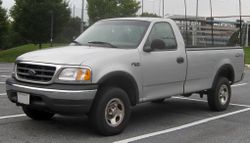 |
|
| Also called | Ford Lobo (Mexico) |
|---|---|
| Production | 1997–2004 |
| Assembly | Cuautitlan, Mexico Kansas City, Missouri, USA Norfolk, Virginia, USA São Bernardo do Campo, Brazil Louisville, Kentucky, USA Oakville, Ontario, Canada |
| Body style(s) | 2-door pickup 3-door pickup 4-door pickup |
| Platform | Ford P platform |
| Engine(s) | 4.2 L (256 CID) Essex V6 4.6 L (281 CID) Triton V8 5.4 L (330 CID) Triton V8 |
| Transmission(s) | 4-speed automatic 5-speed manual |
| Wheelbase | 119.9 in (3,045 mm) 138.5 in (3,518 mm) 157.1 in (3,990 mm) |
| Length | 202.2 in (5,136 mm) 220.8 in (5,608 mm) 225.9 in (5,738 mm) 239.4 in (6,081 mm) |
| Width | 78.4 in (1,991 mm) 79.1 in (2,009 mm) (Crew Cab) |
| Related | Lincoln Blackwood Ford Expedition Lincoln Navigator |

Ford took the aero styling further for 1997 with a rounded nose on the new F-series. Since it was the F-150's first major redesign since 1980, the redesigned truck went on a nation-wide 87-stop tour to Ford plants and the external part suppliers in October, 1995 prior to its release.[7] To build anticipation for the redesigned truck, the 1997 model was released in January 1996 with the first ad campaigns airing during Super Bowl XXX. Because of the radical styling, Ford predicted that traditional truck buyers wouldn't receive the radical and car-like 1997 too well, so it continued to produce and sell the previous 1996 model alongside the redesigned 1997 model for a few months.[8]
The regular F-250 (light duty) was basically an F-150 with the same body panels but with heavy duty axles and suspension, along with 7 lug wheels. Additionally, the F-250 Light Duty also offered a load leveling rear suspension system. The F-250 HD (Heavy Duty) was in the same series as the F-350. With the arrival of the all new 1999 "Super Duty" series in early 1998, the standard F-250 ('light duty'), F-250HD (Heavy Duty), & F-350 line was totally dropped and the F-250 (light duty), which was a temporary model from the start, became the "7700" package for the F-150 (noted on the tailgate emblem).
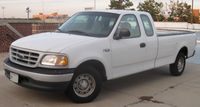
Completely new, more efficient engines were offered beginning in 1997. A 4.2 L OHV V6, based on Ford's 3.8 L Essex V6, replaced the 4.9 L OHV I6, while 4.6 and 5.4 liter SOHC V8s replaced the 5.0 and 5.8 liter OHV V8s, also the 7.5 liter big block V8 was replaced by the 6.8 liter V10 for the super duty models respectively. The 4.6 and 5.4 liter V8s were marketed under the name "Triton" and mark the first use of Ford's Modular Single Overhead Cam (SOHC) engines in the F-Series pickups.
A wide variety of body options were available: regular cab and SuperCab, standard or flareside boxes, and short and long beds. A new Lightning was introduced in 1999, and Harley-Davidson and King Ranch versions were also created. In 2001 the SuperCrew cab was introduced with four full-size doors. In 2002, an FX4 model was introduced which came with skid plates,a carbon steel frame, Rancho shock absorbers, and specific 17" aluminum wheels along with more standard features that were optional on XLT. In 2003, a sporty STX trim package was introduced, aimed at younger truck buyers. The STX package featured color keyed front/rear bumpers along with clear lens headlights and integrated round fog lamps. The package also featured chrome step rails, 17" chrome wheels, and a Kenwood Z828 stereo was installed in place of the standard Ford radio.
 Ford F-150 Flareside |
 Ford F-150 SVT Lightning |
 Ford F-150 King Ranch SuperCrew |
 Ford F-150 Harley Davidson |
 Ford F-150 with custom grille |
This generation F-150 received an overall "Poor" rating by the IIHS in the frontal offset test[9], and was ranked the "2nd Worst Performer" behind the 1997–2005 GM U-platform minivans.
Sales of the F-150 surged in the tenth generation from 750,000 to over 900,000 in 2001 as the General Motors and Dodge products lagged. Ford's sales dropped, however, for the final years of this generation as the redesigned Dodge trucks were released.
The new F-150 was Motor Trend magazine's Truck of the Year for 1997.[10] The grille was updated in 1999 with minor interior updates as well. The SuperCrew was added to the lineup in 2001. Ford manufactured a limited run of "Heritage Edition" F-150s of this body style in 2004 (as 2004 model years) to finish out production. This truck, with an updated grille, is still available in Mexico as a less-expensive alternative to the current trucks.
Ford has found that the cruise control system in many of their trucks could catch fire, because the switch system could corrode over time, overheat and ignite. Ignition was later blamed on spillage from the adjacent master cylinder. On March 5, 2007 Ford recalled 155,000 2003 full-size pickups and full-size SUVs for the defective part. During the previous two years Ford had recalled 5.8 million vehicles in because of the defective cruise control systems in trucks, SUVs and vans. That recall, one of the largest in history, covered vehicles from the 1994–2002 model years.[11]
This generation of F-150 was sold in Mexico until the twelfth generation 2010 model was released there.
Engines:
| Engine | Years | Power | Torque | Notes |
|---|---|---|---|---|
| 4.2 L V6 | 1997–2004 | 202 hp (151 kW) | 252 lb·ft (342 N·m) | |
| 4.6 L V8 | 1997–98 | 220 hp (160 kW) | 280 lb·ft (380 N·m) | |
| 4.6 L V8 | 1999–2004 | 231 hp (172 kW) | 293 lb·ft (397 N·m) | |
| 5.4 L V8 | 1997–98 | 235 hp (175 kW) | 330 lb·ft (450 N·m) | |
| 5.4 L V8 | 1999–2004 | 260 hp (190 kW) | 350 lb·ft (470 N·m) | |
| 5.4 L V8 | 1999–2000 | 360 hp (270 kW) | 450 ft·lbf (610 N·m) | Lightning |
| 5.4 L V8 | 2001–04 | 380 hp (280 kW) | 450 ft·lbf | Lightning |
| 5.4 L V8 | 2002–04 | 340 hp (250 kW) | 425 ft·lbf | Harley-Davidson |
Eleventh generation (2004–2008)
 |
|
| Also called | Ford Lobo (Mexico) |
|---|---|
| Production | 2004–2008 |
| Assembly | Cuautitlan, Mexico Dearborn, Michigan, USA Kansas City, Missouri, USA Norfolk, Virginia, USA Valencia, Venezuela |
| Body style(s) | 2-door pickup 4-door pickup |
| Platform | Ford P2 platform |
| Engine(s) | 4.2 L (256 CID) Essex V6 4.6 L (281 CID) Triton V8 5.4 L (330 CID) Triton V8 |
| Transmission(s) | 4-speed automatic 5-speed manual |
| Wheelbase | SuperCab w/ 8' box 163.0 <126.0 in (Reg. Cab, short box) SuperCab XL & Lariat: 145 in SuperCab STX/FX4/XLT: 133 in Crew Cab: 139 in (3,531 mm) |
| Length | Regular Cab: 211.2 in Ext. cab XL & Lariat: 229.8 in Ext. cab STX/FX4/XLT: 217.8 in Crew Cab: 223.8 in (5,685 mm) |
| Width | 78.9 in |
| Height | 73.5–76.1 in |
| Related | Lincoln Mark LT |
In 2004, Ford redesigned the F-150 using the new P2 platform. The side windows also changed to a Kenworth "Daylight Door" and Ford Super Duty-like appearance; dipping towards the front of the door. Initially, only Ford's 4.6 L Triton or new 3-valve 5.4 L 3V Triton V8 engines and four-speed automatic transmissions were offered to the retail public on the new trucks. In 2005, Ford's 4.2 L Essex V6 and manual transmission became available and standard on base models after they were available only for fleet orders for 2004.
The F-250 and F-350 Ford Super Duties (on the P3 platform) are a different class (over 8,500 lb (3,900 kg) GVWR) than the regular F-series lineup, although they are still F-series trucks.
All F-Series have two large "closed loop" front tow hook design as opposed to conventional open hooks. The F-Series can pull up to 30,000 lb (14,000 kg) with just one hook.
For the 2006 model year beginning in December, 2005, a flex-fuel version of the 3-valve 5.4 L Triton V8 became available.
For 2007, Ford introduced a complement to the existing FX4 model, the new FX2 Sport package (a 2 wheel drive truck with an appearance package).
Ford states a properly equipped 2007 F-150 (Long Wheel Base, 2WD model only) can tow up to 11,000 lb (5,000 kg) maximum and 1800–3050 lb maximum payload.
This generation F-150 got top safety ratings (5 stars) from the NHSTA in frontal collisions, and not only got a "Good" rating from the Insurance Institute for Highway Safety's frontal offset test, but also a Best Pick. The dummy sensors recorded no injuries to any body region.
Saleen offers their own OEM version of the F-150, badged as the S331. Additionally, Roush offers an aftermarket version with similar power. Beginning with the second half of the 2007 model year, Ford offered the Saleen forced-induction package on the Harley edition as an OEM option.
The F-150 Foose Edition debuted in fall 2007 as a 2008 model. Based on an F-150 FX2 Sport, it uses a Roush-developed powertrain. The supercharged 5.4 L V8 puts out 450 hp (340 kW) and 500 lb·ft (680 N·m) of torque.[12]
Awards, sales accomplishments
The new F-150 earned the North American Truck of the Year award for 2004 and was Motor Trend magazine's Truck of the Year for 2004. It also beat the three-time winning Chevrolet Silverado for Car and Driver magazine's Best Pickup Truck for 2004 and 2005. Additionally, over 939,000 F-Series trucks were sold in 2005, a single-year sales record for trucks.
As a popular fleet vehicle, this generation of the F-Series has garnered a number of awards from fleet management professionals. The 2006 F-150 was named Fleet Truck of the Year by Automotive Fleet and Business Fleet magazines,[13] and the 2007 models of the F-150, F-250 and F-350 were chosen Best Fleet Value vehicles in their respective categories by automotive data-analysis firm Vincentric.[14] Winner of the 2006–2007 Golden Icon Award (presented by Travolta Family Entertainment) for "Best Truck".[15]
According to Consumer Reports' used car reliability history data, the 2004–2008 F-150 with the 4.2 L V6 engine is the most reliable American pickup truck ever produced in history. It scored a rating of excellent for five straight consecutive years within one body generation, something that domestics had never earned in the past.
| Engine | Years | Power | Torque |
|---|---|---|---|
| 4.2 L V6 | 2004–2008 | 202 hp (151 kW) | 260 lb·ft (350 N·m) |
| 4.6 L V8 | 2004–2007 | 231 hp (172 kW) | 293 lb·ft (397 N·m) |
| 4.6 L V8 | 2008 | 248 hp (185 kW) | 293 lb·ft (397 N·m) |
| 5.4 L V8 | 2004–2008 | 300 hp (220 kW) | 365 lb·ft (495 N·m) |
 Ford F-150 Lariat SuperCrew |
2007–2008 F-150 Harley Davidson SuperCrew |
2008 F-150 FX2 SuperCrew |
Twelfth generation (2009–present)
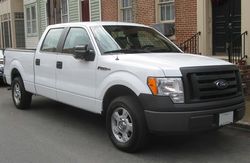 |
|
| Also called | Ford Lobo (Mexico) Lincoln Mark LT (Platinum Version, Mexico) |
|---|---|
| Production | 2008–present |
| Assembly | Dearborn, Michigan, USA Kansas City, Missouri, USA Valencia, Venezuela Cuautitlan, Mexico |
| Body style(s) | 2-door pickup 4-door pickup |
| Platform | Ford P2 platform |
| Engine(s) | 3.5 L EcoBoost V6 3.7 L Cyclone V6 4.6 L (281 CID) 2V V8 4.6 L (281 CID) 3V V8 5.0 L Coyote V8 5.4 L (330 CID) 3V V8 6.2 L 2V V8 |
| Transmission(s) | 4-speed automatic 6-speed automatic |
| Wheelbase | 126 in (3,200 mm) (short bed) 144.5 in (3,670 mm) (long bed) 163 in (4,140 mm) (ext. cab, 8' bed) 138.5 in (3,518 mm) (Crew Cab) |
| Length |
Regular Cab Short Bed: 211.2 in (5,364 mm) Regular & Extended Cab Long Bed: 229.8 in (5,837 mm) Extended Cab Short Bed: 217.8 in (5,532 mm) Extended Cab 8' Bed: 248.4 in (6,309 mm) Crew Cab: 223.8 in (5,685 mm) |
| Width | 78.9 in |
| Height | 73.5–76.5 in (1,867–1,943 mm) |
Ford revealed the next generation 2009 F-150 design at the North American International Auto Show in January, 2008. Production of the series began in October 2008 at Ford's Kansas City Assembly Plant.[16] The truck features a larger and more flexible interior, an updated three-bar grille, and additional choices of cab styles and trim levels. The chassis includes lighter-weight, high strength steel for better fuel economy and safety and improved payload and towing capacity. Three engines were initially offered with the 2009 redesign: a revised 5.4 L 3-valve Triton V8 that is E85 capable with an output rating of 320 hp (240 kW) and 395 lb·ft (536 N·m) of torque, a 292 hp (218 kW) 4.6 L 3-valve V8, and a 248 hp (185 kW) 4.6 L 2-valve V8. The 3-valve 5.4 and 4.6 liter V8s are mated to Ford's new 6R80E 6-speed automatic transmission while the 4R75E 4-speed automatic transmission used previously is carried over for the 2-valve 4.6 L V8. The 4.2 L OHV V6 engine, which was previously available, has been dropped due to the closure of the Essex engine plant where it was produced. A 4.4L diesel V8 under development has been put on hold.
A top-of-the-line Platinum edition F-150 replaced the Lincoln Mark LT truck.[17] However, this trim line is still sold as the Lincoln Mark LT in Mexico.

The 2009 Ford F150 features front-seat side impact airbags and Ford's Safety Canopy System for the first and second rows as Head protection in the event of a side impact. It will also feature Ford's exclusive ADVANCETRAC RSC (Roll Stability Control)--an Electronic Stability control and anti-rollover safety feature also available in other Ford vehicles, from the Fusion to the Expedition.
Beginning in 2009, manual transmissions will no longer be available in the F-150. Manual transmissions will continue to be available in the F-250/F-350 Super duty pickups. 2009 was the last year when Flareside Box was available, and the last year when the 17" wheels for the FX4 Off-Road were available. In 2010 The only box will be Styleside, and the base wheels for FX4 will be 18".
For the 2011 model year, an all-new engine lineup is offered. Two of the engines, a 3.7 L V6 and a 5.0 L V8, are based on the 2011 Ford Mustang engines, and both offer E85 flex-fuel capability. The 6.2 L V8 used in the 2011 Ford Super Duty is available with the F-150 Platinum, Lariat, SVT Raptor, and Harley Davidson editions. Finally, the 3.5 L EcoBoost V6 will be offered in the F-150 starting in early 2011. All engines are paired with a new six-speed automatic transmission [18].
| Engine | Years | Power | Torque |
|---|---|---|---|
| 4.6 L 2V V8 | 2009–2010 | 248 hp (185 kW) @ 4750 rpm | 294 lb·ft (399 N·m) @ 4000 rpm |
| 4.6 L 3V V8 | 2009–2010 | 292 hp (218 kW) @ 5700 rpm | 320 lb·ft (430 N·m) @ 4000 rpm |
| 5.4 L 3V V8 | 2009–2010 | 310 hp (230 kW) @ 5000 rpm | 365 lb·ft (495 N·m) @ 3500 rpm |
| 5.4 L 3V V8 (E85) | 2009–2010 | 320 hp (240 kW) @ 5000 rpm | 390 lb·ft (530 N·m) @ 3500 rpm |
| 3.7 L 4V V6 | 2011 | 300 hp (220 kW) @ 6500 rpm | 275 lb·ft (373 N·m) @ 4500 rpm |
| 3.5 L 4V turbo V6 | 2011 | unknown | unknown |
| 5.0 L 4V V8 | 2011 | 360 hp (270 kW) @ 5500 rpm | 380 lb·ft (520 N·m) @ 4250 rpm |
| 6.2 L 2V V8 | 2011 | 411 hp (306 kW) @ 5500 rpm | 434 lb·ft (588 N·m) @ 4500 rpm |
Ford originally planned to reintroduce the F-100, known internally as P525, as global replacement for Ford Ranger in 2010 or 2011,[19] but the plan was cancelled, instead offering EcoBoost engines for the F-150.[20]
Safety
The F-150 comes standard with AdvanceTrac Electronic Stability Control, front and rear row side curtain airbags, and front row torso side airbags. In IIHS crash tests the F150 received the Good overall score in both front and side impact tests and was given the Top Safety Pick award.[21]
NHTSA F150 crash test results:[22]
- Frontal Driver:





- Frontal Passenger:





- Side Driver:





- Side Rear Passenger:





- 2wd Rollover:





- 4wd Rollover:





SVT Raptor

Ford announced the production of the 2010 F-150 SVT Raptor as a dedicated off-roader. It is powered by a 5.4L engine, with a 6.2L option that is available for purchase now. The 6.2L engine has 411 horsepower (306 kW) and 434 ft·lbf (588 N·m). of torque. The suggested retail price is $3000 over the 5.4L model. A six-speed automatic is standard.[23] It has Fox Racing Shox internal bypass shocks with external reservoirs which allows for 11" of suspension travel in front, and 13" in the rear. It will come standard with 35" BFG All Terrain tires, and a 4.10 ratio locking limited slip rear axle. Also, it will be available in solid black, white, blue, and orange with a "digital mud" decal scheme as an option.[24]
The race version, F-150 SVT Raptor R, was also built for the Baja 1000 races. It uses a 6.2 L engine rated at 500 hp.[25]
The first production Raptor, orange with the digital mud graphic, sold at an auction for $130,000. Ford donated all proceeds above the MSRP to charity.
2010 Harley-Davidson F-150

On February 10, 2009 at the Chicago Auto Show, the latest edition of the F-150 was introduced. Adopting many luxury features of the Platinum Edition, this Harley went one step further by providing leather seating surfaces derived from authentic Harley biker-jacket materials, as well as the requisite exhaust tones and power to reach a top speed of 115 miles per hour (185 km/h).[26]
F-150 Platinum
Ford ceased sales of the Lincoln Mark LT in the United States and Canada after the 2008 model year.[27] In its place beginning in the 2010 model year, Ford created an upper-end trim of the 2009 F-150 called F-150 Platinum. Sales continued in Mexico, because the Ford F-150 was sold as the Ford Lobo until the 2010 model was released there.
Concepts
At the 2008 SEMA show, four 2009 Ford F-150s were unveiled: the F-150 Heavy Duty DEWALT Contractor, the FX-4 by X-Treme Toyz, the F-150 by Street Scene Equipment, and the Hi-Pa Drive F-150. The Heavy Duty DEWALT Contractor was built in a DeWalt theme. The FX-4, also called Fahrenheit F-150, was built for outdoor lifestyle enthusiasts. The Street Scene Equipment version is a lowered truck built with performance and style. The Hi-Pa Drive F-150 was powered by 4 electric in-wheel motors rated over 480 hp (360 kW) and over 375 ft·lbf (508 N·m) torque combined.[28]
Electric/Hybrid Vehicles
Ford will supply Smith Electric Vehicles with a range of its Ford F-Series commercial vehicles as the chassis for Smith's US-specific vehicles. The first of these vehicles is the Faraday mark II, built using the Ford F-650 chassis cab, with a gross vehicle weight (GVW) of up to 13,000 kg (29,000 lb). It manufactures the first of this product in the second half of 2008.[29]
Hybrid Electric Vehicle Technologies (HEVT), Inc.[30] unveiled a plug-in hybrid prototype at 2008 Plug-In Conference and Exposition.[31]
Ford and PML Flightlink worked together to produce the Hi-Pa Drive Ford F150 pickup prototype vehicle[32] which was unveiled at the SEMA show 2008.
Motorsports
In 2008, Ford announced its intention to enter Baja 1000 race class 8 race. The race team consisted driver of record Steve Oligos and co-drivers Randy Merritt, Greg Foutz and Bud Brutsman, competing in class eight for moderately modified full-size pickup trucks.[33] The vehicle was built in collaboration between the Ford Special Vehicle Team (SVT), Ford Racing, and Foutz Motorsports Inc. Ford F-150 SVT Raptor R completed the 2008 41st Tecate SCORE Baja 1000 race in 25:28:10,[34] or 3rd rank within the class.[35]
In Best In The Desert race series, F150 SVT Raptor R completed the "Terrible's 250" race in overall 2nd place in Class 8000.[36]
Awards and recognition
It has won numerous awards; In 2009 alone, the Ford F-150 received:[37]
- Motor Trend 2009 Truck of the Year Award™
- 2009 Best Redesigned Vehicle from Kelley Blue Book’s kbb.com
- Top honors as "Truck of Texas" as well as "Best Luxury Pickup" for the 2009 F-150 King Ranch from Texas Auto Writers Association
- "Best Overall Half-Ton Pickup" from PickupTrucks.com
- "Automotive Excellence" award in the Workhorse Category from Popular Mechanics
- "Top Safety Pick" from the Insurance Institute for Highway Safety for its standard safety technology: Safety Canopy side curtain air bags and AdvanceTrac with Roll Stability Control
- "Residual Value" award from Automotive Leasing Guide (ALG) for retaining the highest percentage of its original price among 2009 full-size light duty pickups at the end of a conventional three-year lease, based on ALG projections
- Motor Trend's Truck Trend Top 5 Trucks from Specialty Equipment Market Association (SEMA) for 2009 Ford F-150 Heavy Duty DeWalt Contractor Concept
- "Accessory-Friendly Truck" Design Award from SEMA
Yearly American sales
| Calendar Year | Total American sales |
|---|---|
| 1999[38] | 869,001 |
| 2000 | 876,716 |
| 2001 | 823,681 |
| 2002[39] | 813,701 |
| 2003 | 845,586 |
| 2004[40] | 939,511 |
| 2005 | 901,463 |
| 2006[41] | 796,039 |
| 2007 | 690,589 |
| 2008[42] | 515,513 |
| 2009[43] | 413,625 |
Notes
- Ford also manufactures F-Series medium and heavy-duty trucks alongside the F-150, F-250, and F-350s.(F-450, F-550, F-650, F-750). School bus chassis versions are sold as B-Series trucks. The 1961–1965 Ford Falcon Econoline flat nose pickup trucks and 1961–present vans are E-Series. Parcel delivery vans are P-Series. Big tractor trailer trucks are L-Series. There was also a class 8 cab over called the W-Series in the 60s-70s, replaced by the CL-Series in 1977.
- In Argentina and Brazil, the gasoline engines are often converted to also run with alternative fuels, E-96h (Brazilian-spec ethanol) and CNG (Compressed Natural Gas). Biodiesel also is used in diesel engines.
- Ford also built Right-hand drive versions of the F-Series in Brazil for export to countries that drive on the left side of the road, like the United Kingdom and Australia.
- Prior to the F-650 and F-750 medium-duty trucks, Ford offered F-700, F-800 and F-900 medium-duty trucks that retained the door and aft cab (A-pillar back) style and structure from the previous generation F-Series, along with the dash and instrument cluster (from early 1980s models). Current models are based on the International 4000 Series chassis with a Ford Super Duty cab.
- An F-8000 was also produced based on the Ford Cargo cab-over range, which was similar to the 2006 and newer Ford LCF ("Low Cab Forward").
- In Mexico the 1997-2003 style F-150 is still built and sold with the F-150 having a 4.2L V6 and the F-250 (with the same styling, interior, etc) having a 4.6L V8. The US-market F-150 is sold as the Ford Lobo.
- Despite its unpopularity in the US, the Lincoln Mark LT (version of the US-market F-150) continues to be sold in Mexico.
See also
- Ford Super Duty
- Ford F-650
- Sterling Trucks Bullet pickup
Footnotes
- ↑ Ford Motor Company (2007-05-25). "Ford's Best Selling Pickups Add More Features For 2008". Truck Trend (Auto News). http://www.trucktrend.com/features/news/2007/163_news070524_2008_ford_trucks_features.
- ↑ Magda, Mike (2006-02-05). "Interview with GMC Sierra Brand Manager Lorraine Babiar". Pickuptruck.com. http://www.pickuptruck.com/html/autoshows/naias2006/gmc/interview1.html.
- ↑ 1967 Ford F-100 hood insignia
- ↑ 1968-62 Ford F-100 hood insignia
- ↑ http://72.30.186.56/babelfish/translate_url_content?lp=pt_en&trurl=http%3a%2f%2fwww2.uol.com.br%2fbestcars%2fcpassado%2ff1000-5.htm 1991
- ↑ Photo of an early model at HowStuffWorks.com
- ↑ "Press Release: FORD PLANTS AND SUPPLIERS GET SNEAK PEEK AT 1997 FORD F-150 – PR Newswire | HighBeam Research: Online Press Releases". Highbeam.com. 1995-10-16. http://www.highbeam.com/doc/1G1-17610463.html. Retrieved 2009-08-30.
- ↑ "Article: Contractors eyeball new pickup from Ford, like what they see. (1997... | AccessMyLibrary – Promoting library advocacy". AccessMyLibrary. 1996-02-05. http://www.accessmylibrary.com/coms2/summary_0286-6357019_ITM. Retrieved 2009-08-30.
- ↑ "Ford F-150, 1997–2003 models". Insurance Institute for Highway Safety. September 2, 2005. http://www.iihs.org/ratings/rating.aspx?id=7. Retrieved 2009-05-14.
- ↑ "Truck of the Year Winners List". Motor Trend. http://www.motortrend.com/oftheyear/truck/truck_of_the_year_winners/index.html.
- ↑ Ford F150 Recall Information – Ford Recalls & Problems
- ↑ "New York Preview: Ford F-150 Foose Edition debuts". Autoblog.com. March 30, 2007. http://www.autoblog.com/2007/03/30/new-york-preview-ford-f-150-foose-edition-debuts/. Retrieved 2008-09-10.
- ↑ "New Chevy Impala and Ford F-150 Win Fleet Segment Awards". Automobile.com. http://car-reviews.automobile.com/news/new-chevy-impala-and-ford-f-150-win-fleet-segment-awards/1585/.
- ↑ "Vincentric announces best fleet value awards". Vincentric. March 15, 2007. http://www.vincentric.com/Home/AboutUs/Newsroom/PressReleases/PRBestfleetawardsannounced031507/tabid/375/Default.aspx. Retrieved 2009-05-14.
- ↑ "Zack Snyder's Film "300" tops in Golden Icon Awards". Axcess News. 2007. http://axcessnews.com/index.php/articles/show/id/12342. Retrieved 2008-02-05.
- ↑ "Ford's Kansas City Assembly Plant employees celebrate production of NEW 2009 Ford F-150". Media.Ford.com. October 2, 2008. http://media.ford.com/article_display.cfm?article_id=29165.
- ↑ "DETNEWS | WebVideo | 2009 Ford F-150 Platinum". Info.detnews.com. 2008-01-13. http://info.detnews.com/video/index.cfm?id=1756. Retrieved 2009-04-28.
- ↑ http://media.ford.com/article_display.cfm?article_id=33096
- ↑ Neff, John (June 2, 2008). "Ford planning F-100 and global Ranger replacement". Autoblog. http://www.autoblog.com/2008/06/02/ford-planning-f100-and-global-ranger-replacement/. Retrieved 2009-05-14.
- ↑ Holland, Bob (August 8, 2008). "Ford tables plans for F-100 pickup". Edmunds Inside Line. http://blogs.edmunds.com/straightline/2008/08/ford-tables-plans-for-f-100-pickup.html. Retrieved 2009-05-14.
- ↑ "2009 Ford F-150". Insurance Institute for Highway Safety. http://www.iihs.org/ratings/ratingsbyseries.aspx?id=327. Retrieved 2009-04-28.
- ↑ "2009 Ford F-150 4-DR w/SAB". Safercar.gov. NHTSA. http://www.safercar.gov/portal/search?model=7897. Retrieved 2009-04-28.
- ↑ "2010 Ford F-150 SVT Raptor". Fox News. 2009-09-17. http://www.foxnews.com/story/0,2933,548721,00.html.
- ↑ Phillips, Drew (November 4, 2008). "SEMA 2008: Ford F-150 SVT Raptor unveiled in its natural environment". http://www.autoblog.com/2008/11/04/sema-2008-ford-f-150-svt-raptor-unveiled-in-its-natural-environ/. Retrieved 2009-05-14.
- ↑ Phillips, Drew (November 4, 2008). "SEMA 2008: SVT Raptor R race truck to enter Baja 1000". Autoblog. http://www.autoblog.com/2008/11/04/sema-2008-svt-raptor-r-race-truck-to-enter-baja-1000/. Retrieved 2009-05-14.
- ↑ "New 2010 Ford Harley-Davidson F-150: tough truck with cool attitude; new details, inside and out". Media.ford.com. February 10, 2009. http://www.media.ford.com/article_display.cfm?article_id=29845. Retrieved 2009-04-28.
- ↑ "RIP: Lincoln Mark LT". September 2007. http://www.edmunds.com/insideline/do/News/articleId=122468. Retrieved 2007-09-04.
- ↑ Lavrinc, Damon (October 30, 2008). "SEMA Preview: Ford bringing four F-150s to Sin City". Autoblog. http://www.autoblog.com/2008/10/30/sema-preview-ford-bringing-four-f-150s-to-sin-city/. Retrieved 2009-05-14.
- ↑ "Launch of new zero-emission electric vehicles in collaboration with Ford". Smith Electric Vehicles. http://www.smithelectricvehicles.com/newsevents_news.asp?p=n&itemid=204.
- ↑ "Hybrid Electric Vehicle Technologies, Inc (HEVT) | An IIT (Illinois Institute of Technology) Startup in Chicago | Home". HEVT. http://www.hevt.com. Retrieved 2009-04-28.
- ↑ Siler, Wes (July 24, 2008). "HEV Technology Builds 41 MPG Plug-In Hybrid Ford F-150 Pickup Truck". Jalopnik. http://jalopnik.com/399208/hev-technology-builds-41-mpg-plug+in-hybrid-ford-f+150-pickup-truck.
- ↑ Hi-Pa Drive Ford F150
- ↑ Ford SVT F-150 Raptor R to enter Baja 1000...
- ↑ Ford F-150 SVT Raptor R completes inaugural run of Baja 1000
- ↑ 2008 Baja 1000 class results
- ↑ 2010 FORD F150 SVT RAPTOR R CAPTURES PODIUM FINISH; PRICING ANNOUNCED
- ↑ 2009 FORD F-150 AWARDS
- ↑ "Ford Motor Company Sets New Full Year U.S. Sales Record". Theautochannel.com. http://www.theautochannel.com/news/press/date/20010103/press033466.html. Retrieved 2009-04-28.
- ↑ "Ford's F-Series Truck Caps 22nd Year in a Row as America's Best-Selling Vehicle With a December Sales Record". Theautochannel.com. 2004-11-17. http://www.theautochannel.com/news/2004/01/05/175829.html. Retrieved 2009-04-28.
- ↑ "Ford Achieves First Car Sales Increase Since 1999". Theautochannel.com. 2004-11-17. http://www.theautochannel.com/news/2006/01/04/204860.html. Retrieved 2009-04-28.
- ↑ "Ford Motor Company 2007 sales". January 3, 2008. http://media.ford.com/article_download.cfm?article_id=27379.
- ↑ "F-Series drives ford to higher market share for third consecutive month". Ford Motor Company. January 5, 2009. http://media.ford.com/images/10031/dec08sales.pdf. Retrieved 2009-05-14.
- ↑ "FORD CAPS 2009 WITH 33 PERCENT SALES INCREASE, FIRST FULL-YEAR MARKET SHARE GAIN SINCE 1995". Ford Motor Company. January 5, 2010. http://media.ford.com/images/10031/December09sales.pdf. Retrieved 2010-01-05.
References
- "A Ford F-Series History". Edmunds.com. http://www.edmunds.com/reviews/generations/articles/46026/article.html. Retrieved November 8, 2004.
Chassis and model spec for 1957–1979 from Ford Master Parts Catalog
External links
|
|||||||||||||||||
| Type | 1940s | 1950s | 1960s | 1970s | ||||||||||||||||||||||||||||
| 8 | 9 | 0 | 1 | 2 | 3 | 4 | 5 | 6 | 7 | 8 | 9 | 0 | 1 | 2 | 3 | 4 | 5 | 6 | 7 | 8 | 9 | 0 | 1 | 2 | 3 | 4 | 5 | 6 | 7 | 8 | 9 | |
| SUV | Bronco | Bronco | ||||||||||||||||||||||||||||||
| Coupé utility | Ranchero | Ranchero | Ranchero | Ranchero | Ranchero | Ranchero | Ranchero | |||||||||||||||||||||||||
| Compact pickup | Courier | Courier | ||||||||||||||||||||||||||||||
| Full-size pickup | F-Series | F-Series | F-Series | F-Series | F-Series | F-Series | ||||||||||||||||||||||||||
| Van | Econoline | Econoline | Econoline / Club Wagon | |||||||||||||||||||||||||||||
| Type | 1980s | 1990s | 2000s | 2010s | ||||||||||||||||||||||||||||
| 0 | 1 | 2 | 3 | 4 | 5 | 6 | 7 | 8 | 9 | 0 | 1 | 2 | 3 | 4 | 5 | 6 | 7 | 8 | 9 | 0 | 1 | 2 | 3 | 4 | 5 | 6 | 7 | 8 | 9 | 0 | 1 | |
| Mid-size crossover | Edge | |||||||||||||||||||||||||||||||
| Full-size crossover | Freestyle | Taurus X | ||||||||||||||||||||||||||||||
| Flex | ||||||||||||||||||||||||||||||||
| Compact SUV | Bronco II | Bronco II | Escape | Escape | ||||||||||||||||||||||||||||
| Mid-size SUV | Explorer | Explorer | Explorer | Explorer | Explorer | |||||||||||||||||||||||||||
| Full-size SUV | Bronco | Bronco | Bronco | Expedition | Expedition | Expedition | ||||||||||||||||||||||||||
| Excursion | Expedition EL/Max | |||||||||||||||||||||||||||||||
| Compact pickup | Courier | Ranger | Ranger | Ranger | Ranger | |||||||||||||||||||||||||||
| Mid-size pickup | Explorer Sport Trac | Explorer Sport Trac | ||||||||||||||||||||||||||||||
| Full-size pickup | F-Series | F-Series | F-Series | F-Series | F-Series | F-Series | ||||||||||||||||||||||||||
| Super Duty | Super Duty | |||||||||||||||||||||||||||||||
| Minivan | Aerostar | Aerostar | Transit Connect | |||||||||||||||||||||||||||||
| Windstar | Windstar | Freestar | ||||||||||||||||||||||||||||||
| Van | Econoline | Econoline/E-Series | ||||||||||||||||||||||||||||||